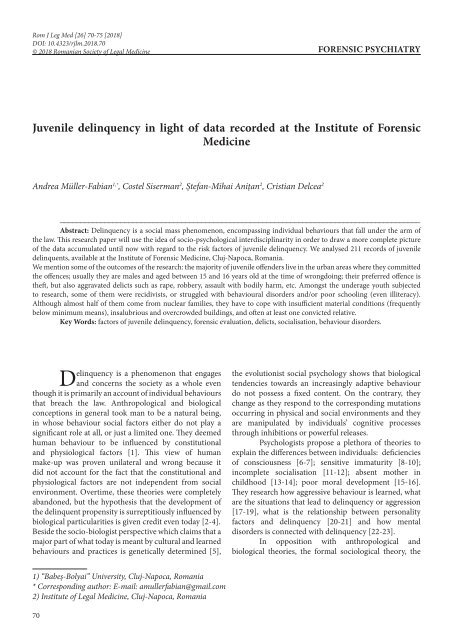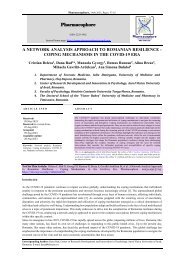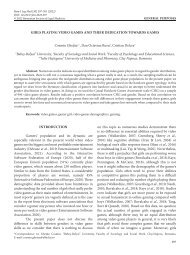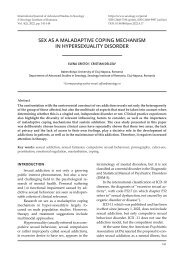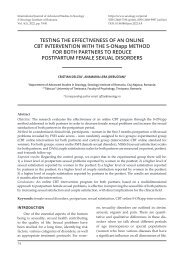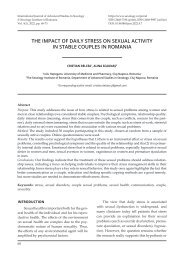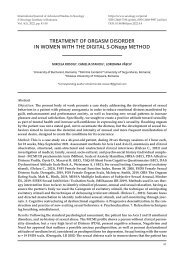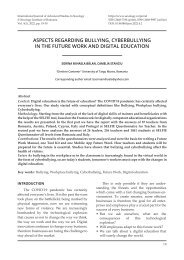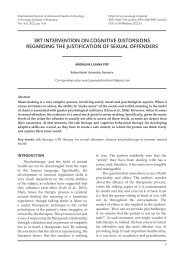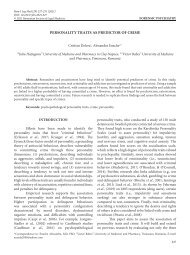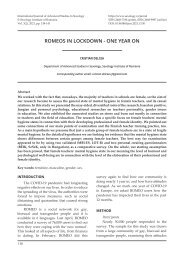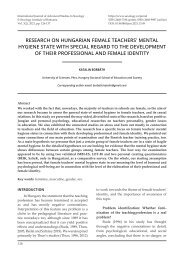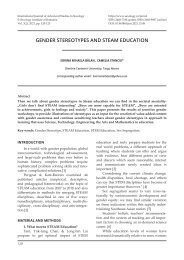Juvenile delinquency in light of data recorded at the Institute of Forensic Medicine
Delinquency is a social mass phenomenon, encompassing individual behaviours that fall under the arm of the law. This research paper will use the idea of socio-psychological interdisciplinarity in order to draw a more complete picture of the data accumulated until now with regard to the risk factors of juvenile delinquency. We analysed 211 records of juvenile delinquents, available at the Institute of Forensic Medicine, Cluj-Napoca, Romania. We mention some of the outcomes of the research: the majority of juvenile offenders live in the urban areas where they committed the offences; usually they are males and aged between 15 and 16 years old at the time of wrongdoing; their preferred offence is theft, but also aggravated delicts such as rape, robbery, assault with bodily harm, etc. Amongst the underage youth subjected to research, some of them were recidivists, or struggled with behavioural disorders and/or poor schooling (even illiteracy). Although almost half of them come from nuclear families, they have to cope with insufficient material conditions (frequently below minimum means), insalubrious and overcrowded buildings, and often at least one convicted relative.
Delinquency is a social mass phenomenon, encompassing individual behaviours that fall under the arm of
the law. This research paper will use the idea of socio-psychological interdisciplinarity in order to draw a more complete picture
of the data accumulated until now with regard to the risk factors of juvenile delinquency. We analysed 211 records of juvenile
delinquents, available at the Institute of Forensic Medicine, Cluj-Napoca, Romania.
We mention some of the outcomes of the research: the majority of juvenile offenders live in the urban areas where they committed
the offences; usually they are males and aged between 15 and 16 years old at the time of wrongdoing; their preferred offence is
theft, but also aggravated delicts such as rape, robbery, assault with bodily harm, etc. Amongst the underage youth subjected
to research, some of them were recidivists, or struggled with behavioural disorders and/or poor schooling (even illiteracy).
Although almost half of them come from nuclear families, they have to cope with insufficient material conditions (frequently
below minimum means), insalubrious and overcrowded buildings, and often at least one convicted relative.
Create successful ePaper yourself
Turn your PDF publications into a flip-book with our unique Google optimized e-Paper software.
Rom J Leg Med [26] 70-75 [2018]<br />
DOI: 10.4323/rjlm.2018.70<br />
© 2018 Romanian Society <strong>of</strong> Legal Medic<strong>in</strong>e<br />
FORENSIC PSYCHIATRY<br />
<strong>Juvenile</strong> <strong>del<strong>in</strong>quency</strong> <strong>in</strong> <strong>light</strong> <strong>of</strong> <strong>d<strong>at</strong>a</strong> <strong>recorded</strong> <strong>at</strong> <strong>the</strong> <strong>Institute</strong> <strong>of</strong> <strong>Forensic</strong><br />
Medic<strong>in</strong>e<br />
Andrea Müller-Fabian 1,* , Costel Siserman 2 , Ștefan-Mihai Anițan 2 , Cristian Delcea 2<br />
_________________________________________________________________________________________<br />
Abstract: Del<strong>in</strong>quency is a social mass phenomenon, encompass<strong>in</strong>g <strong>in</strong>dividual behaviours th<strong>at</strong> fall under <strong>the</strong> arm <strong>of</strong><br />
<strong>the</strong> law. This research paper will use <strong>the</strong> idea <strong>of</strong> socio-psychological <strong>in</strong>terdiscipl<strong>in</strong>arity <strong>in</strong> order to draw a more complete picture<br />
<strong>of</strong> <strong>the</strong> <strong>d<strong>at</strong>a</strong> accumul<strong>at</strong>ed until now with regard to <strong>the</strong> risk factors <strong>of</strong> juvenile <strong>del<strong>in</strong>quency</strong>. We analysed 211 records <strong>of</strong> juvenile<br />
del<strong>in</strong>quents, available <strong>at</strong> <strong>the</strong> <strong>Institute</strong> <strong>of</strong> <strong>Forensic</strong> Medic<strong>in</strong>e, Cluj-Napoca, Romania.<br />
We mention some <strong>of</strong> <strong>the</strong> outcomes <strong>of</strong> <strong>the</strong> research: <strong>the</strong> majority <strong>of</strong> juvenile <strong>of</strong>fenders live <strong>in</strong> <strong>the</strong> urban areas where <strong>the</strong>y committed<br />
<strong>the</strong> <strong>of</strong>fences; usually <strong>the</strong>y are males and aged between 15 and 16 years old <strong>at</strong> <strong>the</strong> time <strong>of</strong> wrongdo<strong>in</strong>g; <strong>the</strong>ir preferred <strong>of</strong>fence is<br />
<strong>the</strong>ft, but also aggrav<strong>at</strong>ed delicts such as rape, robbery, assault with bodily harm, etc. Amongst <strong>the</strong> underage youth subjected<br />
to research, some <strong>of</strong> <strong>the</strong>m were recidivists, or struggled with behavioural disorders and/or poor school<strong>in</strong>g (even illiteracy).<br />
Although almost half <strong>of</strong> <strong>the</strong>m come from nuclear families, <strong>the</strong>y have to cope with <strong>in</strong>sufficient m<strong>at</strong>erial conditions (frequently<br />
below m<strong>in</strong>imum means), <strong>in</strong>salubrious and overcrowded build<strong>in</strong>gs, and <strong>of</strong>ten <strong>at</strong> least one convicted rel<strong>at</strong>ive.<br />
Key Words: factors <strong>of</strong> juvenile <strong>del<strong>in</strong>quency</strong>, forensic evalu<strong>at</strong>ion, delicts, socialis<strong>at</strong>ion, behaviour disorders.<br />
Del<strong>in</strong>quency is a phenomenon th<strong>at</strong> engages<br />
and concerns <strong>the</strong> society as a whole even<br />
though it is primarily an account <strong>of</strong> <strong>in</strong>dividual behaviours<br />
th<strong>at</strong> breach <strong>the</strong> law. Anthropological and biological<br />
conceptions <strong>in</strong> general took man to be a n<strong>at</strong>ural be<strong>in</strong>g,<br />
<strong>in</strong> whose behaviour social factors ei<strong>the</strong>r do not play a<br />
significant role <strong>at</strong> all, or just a limited one. They deemed<br />
human behaviour to be <strong>in</strong>fluenced by constitutional<br />
and physiological factors [1]. This view <strong>of</strong> human<br />
make-up was proven unil<strong>at</strong>eral and wrong because it<br />
did not account for <strong>the</strong> fact th<strong>at</strong> <strong>the</strong> constitutional and<br />
physiological factors are not <strong>in</strong>dependent from social<br />
environment. Overtime, <strong>the</strong>se <strong>the</strong>ories were completely<br />
abandoned, but <strong>the</strong> hypo<strong>the</strong>sis th<strong>at</strong> <strong>the</strong> development <strong>of</strong><br />
<strong>the</strong> del<strong>in</strong>quent propensity is surreptitiously <strong>in</strong>fluenced by<br />
biological particularities is given credit even today [2-4].<br />
Beside <strong>the</strong> socio-biologist perspective which claims th<strong>at</strong> a<br />
major part <strong>of</strong> wh<strong>at</strong> today is meant by cultural and learned<br />
behaviours and practices is genetically determ<strong>in</strong>ed [5],<br />
<strong>the</strong> evolutionist social psychology shows th<strong>at</strong> biological<br />
tendencies towards an <strong>in</strong>creas<strong>in</strong>gly adaptive behaviour<br />
do not possess a fixed content. On <strong>the</strong> contrary, <strong>the</strong>y<br />
change as <strong>the</strong>y respond to <strong>the</strong> correspond<strong>in</strong>g mut<strong>at</strong>ions<br />
occurr<strong>in</strong>g <strong>in</strong> physical and social environments and <strong>the</strong>y<br />
are manipul<strong>at</strong>ed by <strong>in</strong>dividuals’ cognitive processes<br />
through <strong>in</strong>hibitions or powerful releases.<br />
Psychologists propose a plethora <strong>of</strong> <strong>the</strong>ories to<br />
expla<strong>in</strong> <strong>the</strong> differences between <strong>in</strong>dividuals: deficiencies<br />
<strong>of</strong> consciousness [6-7]; sensitive imm<strong>at</strong>urity [8-10];<br />
<strong>in</strong>complete socialis<strong>at</strong>ion [11-12]; absent mo<strong>the</strong>r <strong>in</strong><br />
childhood [13-14]; poor moral development [15-16].<br />
They research how aggressive behaviour is learned, wh<strong>at</strong><br />
are <strong>the</strong> situ<strong>at</strong>ions th<strong>at</strong> lead to <strong>del<strong>in</strong>quency</strong> or aggression<br />
[17-19], wh<strong>at</strong> is <strong>the</strong> rel<strong>at</strong>ionship between personality<br />
factors and <strong>del<strong>in</strong>quency</strong> [20-21] and how mental<br />
disorders is connected with <strong>del<strong>in</strong>quency</strong> [22-23].<br />
In opposition with anthropological and<br />
biological <strong>the</strong>ories, <strong>the</strong> formal sociological <strong>the</strong>ory, <strong>the</strong><br />
1) “Babeș-Bolyai” University, Cluj-Napoca, Romania<br />
* Correspond<strong>in</strong>g author: E-mail: amullerfabian@gmail.com<br />
2) <strong>Institute</strong> <strong>of</strong> Legal Medic<strong>in</strong>e, Cluj-Napoca, Romania<br />
70
Romanian Journal <strong>of</strong> Legal Medic<strong>in</strong>e Vol. XXVI, No 1(2018)<br />
factorial <strong>the</strong>ory underscored <strong>the</strong> exclusive and decisive<br />
role <strong>of</strong> external factors <strong>in</strong> shap<strong>in</strong>g human behaviour [24-<br />
25]. Today it is unanimously agreed th<strong>at</strong> <strong>the</strong> unil<strong>at</strong>erality<br />
and exclusivism <strong>of</strong> both <strong>the</strong>ories cannot be uphold.<br />
L<strong>at</strong>er on, sociological <strong>the</strong>ories confirmed <strong>the</strong><br />
import <strong>of</strong> psychological tendency <strong>in</strong> <strong>the</strong> development<br />
<strong>of</strong> social phenomena. It is certa<strong>in</strong> th<strong>at</strong> <strong>the</strong>re is biological<br />
determ<strong>in</strong>ism <strong>in</strong> human behaviour (for example,<br />
aggression and its role <strong>in</strong> <strong>del<strong>in</strong>quency</strong>), but its share<br />
<strong>in</strong> human conduct is still hotly deb<strong>at</strong>ed. Consequently,<br />
we should <strong>in</strong>vestig<strong>at</strong>e <strong>the</strong> backstory and <strong>the</strong> family<br />
precedents <strong>of</strong> <strong>the</strong> juvenile del<strong>in</strong>quent. One should also<br />
pay <strong>at</strong>tention to how one’s psychic structure determ<strong>in</strong>es<br />
human behaviour.<br />
By a complex exam<strong>in</strong><strong>at</strong>ion <strong>of</strong> social, familyrel<strong>at</strong>ed,<br />
school<strong>in</strong>g, and subjective factors, <strong>the</strong> researcher<br />
is able to g<strong>at</strong>her important <strong>d<strong>at</strong>a</strong> with regard to <strong>the</strong> genesis<br />
<strong>of</strong> juvenile <strong>del<strong>in</strong>quency</strong>. Armed with this <strong>in</strong>form<strong>at</strong>ion,<br />
one can discover <strong>the</strong> early causes th<strong>at</strong> lead to <strong>the</strong> onset<br />
<strong>of</strong> del<strong>in</strong>quent conduct. In this paper, <strong>the</strong>refore, we<br />
will benefit from partak<strong>in</strong>g <strong>in</strong> social-psychological<br />
<strong>in</strong>terdiscipl<strong>in</strong>arity: it will allow us to build a more<br />
accur<strong>at</strong>e and complete portrait <strong>of</strong> risk factors <strong>in</strong> juvenile<br />
<strong>del<strong>in</strong>quency</strong>.<br />
MATERIAL AND METHODS<br />
In view <strong>of</strong> our research, we contacted <strong>the</strong><br />
<strong>Institute</strong> <strong>of</strong> <strong>Forensic</strong> Medic<strong>in</strong>e “M<strong>in</strong>a M<strong>in</strong>ovici” from<br />
Cluj-Napoca, which gave us access to 211 record files <strong>of</strong><br />
juvenile del<strong>in</strong>quents.<br />
We used as research methods <strong>the</strong> analysis <strong>of</strong><br />
juvenile del<strong>in</strong>quents’ records, writ<strong>in</strong>g down and analys<strong>in</strong>g<br />
st<strong>at</strong>istically <strong>the</strong> most significant <strong>d<strong>at</strong>a</strong>.<br />
RESULTS<br />
From 211 forensic <strong>in</strong>vestig<strong>at</strong>ions and assessments<br />
carried out <strong>in</strong> <strong>del<strong>in</strong>quency</strong> cases, <strong>the</strong> majority <strong>of</strong> <strong>of</strong>fenders<br />
were boys (194). Age-wise, <strong>the</strong> most <strong>of</strong>fences were<br />
committed by m<strong>in</strong>ors aged 15-16 years, 41.75% <strong>of</strong> boys<br />
and 64.70% <strong>of</strong> girls. Boys aged both between 14 and 15<br />
years old and 16 to 17 years old committed approxim<strong>at</strong>ely<br />
<strong>the</strong> same percentage <strong>of</strong> <strong>of</strong>fences: 24.74% (14-15 years old)<br />
and 25.75% (16-17 years old). This percentage is loosely<br />
<strong>the</strong> same for girls, with <strong>the</strong> remark th<strong>at</strong> it is higher for<br />
14-15 years old girls (17.64%) than 16-17 years old ones<br />
(11.76%). For both genders, <strong>the</strong> del<strong>in</strong>quent behaviour<br />
had decreased <strong>at</strong> <strong>the</strong> age <strong>of</strong> 17-18 years old, <strong>in</strong> boys’<br />
case go<strong>in</strong>g as low as 7.73%, while for girls even lower:<br />
5.88%. Offences committed by <strong>the</strong> juvenile del<strong>in</strong>quents<br />
concerned are shown <strong>in</strong> Figure 1.<br />
One can notice <strong>the</strong> high frequency <strong>of</strong> <strong>the</strong>fts:<br />
serious <strong>the</strong>fts with destruction <strong>of</strong> common property<br />
and goods, grand <strong>the</strong>fts and aggrav<strong>at</strong>ed <strong>the</strong>fts. Special<br />
<strong>at</strong>tention should be paid to robberies, mugg<strong>in</strong>s, assaults,<br />
break<strong>in</strong>g and enter<strong>in</strong>g, driv<strong>in</strong>g a vehicle without licence,<br />
abett<strong>in</strong>g and withhold<strong>in</strong>g.<br />
Rape and sexual perversion are usually specific<br />
to adults, but, albeit <strong>in</strong> rare <strong>in</strong>stances, <strong>the</strong>y can be<br />
committed by juveniles. Identity forgery is a complex<br />
and high-risk delict because most <strong>of</strong> <strong>the</strong> time is set <strong>of</strong>f by<br />
ano<strong>the</strong>r act th<strong>at</strong> is an <strong>of</strong>fence. Normally, identity forgery<br />
is carried out by adults, but when executed by youngsters<br />
it means th<strong>at</strong> he/she is under <strong>the</strong> <strong>in</strong>fluence <strong>of</strong> an adult<br />
<strong>of</strong>fender. Likewise, prostitution – a stomp<strong>in</strong>g ground<br />
for adult crim<strong>in</strong>als – can be practised by girls under <strong>the</strong><br />
“custody” <strong>of</strong> elder partners, who encourage <strong>the</strong>m or,<br />
more frequently, constra<strong>in</strong> <strong>the</strong>m to sell <strong>the</strong>ir bodies for<br />
money. As <strong>the</strong> chart above shows, beside prostitution,<br />
girls were <strong>in</strong>dicted also for priv<strong>at</strong>e and public <strong>the</strong>ft, for<br />
destruction <strong>of</strong> priv<strong>at</strong>e property and blackmail.<br />
To undertake a thorough analysis <strong>of</strong> <strong>the</strong> record<br />
files, we took <strong>in</strong>to account <strong>the</strong> school trajectory <strong>of</strong><br />
juvenile del<strong>in</strong>quents. More than ¼ <strong>of</strong> young <strong>of</strong>fenders are<br />
illiter<strong>at</strong>es or semi-illiter<strong>at</strong>es. Around 35% went to primary<br />
Figure 1. Offences comitted.<br />
71
Müller-Fabian A. et al.<br />
<strong>Juvenile</strong> <strong>del<strong>in</strong>quency</strong> <strong>in</strong> <strong>light</strong> <strong>of</strong> <strong>d<strong>at</strong>a</strong> <strong>recorded</strong> <strong>at</strong> <strong>the</strong> <strong>Institute</strong> <strong>of</strong> <strong>Forensic</strong> Medic<strong>in</strong>e<br />
school, and 20% came from trade schools or <strong>the</strong>oretical<br />
high schools. Approxim<strong>at</strong>ely 10% are pupils from special<br />
needs schools or <strong>the</strong>y just abandoned school.<br />
Inform<strong>at</strong>ion about <strong>the</strong> health condition <strong>of</strong><br />
juvenile del<strong>in</strong>quents are shown <strong>in</strong> Figure 2.<br />
Approxim<strong>at</strong>ely 90% <strong>of</strong> juvenile del<strong>in</strong>quents have<br />
not had an illness until today. CNS (central nervous<br />
system) afflictions were spotted <strong>in</strong> only 2% <strong>of</strong> cases. Low<br />
IQ and behavioural disorders were manifested by 6%<br />
<strong>of</strong> del<strong>in</strong>quents and o<strong>the</strong>r 2% <strong>of</strong> <strong>the</strong>m suffered serious<br />
diseases th<strong>at</strong> did not, however, impair <strong>the</strong> CNS.<br />
We did not encounter dur<strong>in</strong>g our research<br />
<strong>in</strong>tra-family afflictions, which would certa<strong>in</strong>ly act as a<br />
propeller <strong>of</strong> <strong>del<strong>in</strong>quency</strong>. Over 87% <strong>of</strong> young <strong>of</strong>fenders<br />
came from healthy families. In approxim<strong>at</strong>ely 5% <strong>of</strong><br />
cases, <strong>the</strong>y had parents suffer<strong>in</strong>g from CNS diseases.<br />
Medical conditions th<strong>at</strong> seriously deplete <strong>the</strong> family<br />
budget were found <strong>in</strong> 10% <strong>of</strong> those subject to research.<br />
TB afflicted parents were registered for 3%, deceased for<br />
6% and sickly retirees for 1%.<br />
Our <strong>in</strong>vestig<strong>at</strong>ion laid bare <strong>the</strong> fact th<strong>at</strong> <strong>at</strong> least<br />
one parent was convicted <strong>in</strong> <strong>the</strong> families <strong>of</strong> more than<br />
15% <strong>of</strong> juvenile del<strong>in</strong>quents.<br />
By study<strong>in</strong>g <strong>the</strong> family <strong>in</strong>come <strong>of</strong> young<br />
<strong>of</strong>fenders, one can see th<strong>at</strong> approxim<strong>at</strong>ively 50% have an<br />
<strong>in</strong>sufficient <strong>in</strong>come or an <strong>in</strong>come below <strong>the</strong> m<strong>in</strong>imum<br />
wage, respectively – accord<strong>in</strong>g to Cătăl<strong>in</strong> Zamfir’s<br />
c<strong>at</strong>egories [26]. We also found families <strong>in</strong> which a stable<br />
<strong>in</strong>come was lack<strong>in</strong>g for years.<br />
Regard<strong>in</strong>g family components, 47% <strong>of</strong><br />
del<strong>in</strong>quents come from nuclear families. More than 40%<br />
<strong>of</strong> <strong>the</strong>m live <strong>in</strong> large families.<br />
Look<strong>in</strong>g <strong>at</strong> youngsters’ behaviour, one notices<br />
th<strong>at</strong> <strong>in</strong> many cases <strong>the</strong>re is evidence <strong>of</strong> conduct disorder.<br />
The <strong>d<strong>at</strong>a</strong> collected <strong>in</strong> our <strong>in</strong>vestig<strong>at</strong>ion show th<strong>at</strong> over<br />
50% <strong>of</strong> m<strong>in</strong>ors displayed behaviour disorders before<br />
committ<strong>in</strong>g <strong>of</strong>fences. Thus, some <strong>of</strong> <strong>the</strong>m strayed, were<br />
dis<strong>in</strong>terested <strong>in</strong> school, repe<strong>at</strong>ed an academic year, were<br />
aggressive towards <strong>the</strong>ir schoolm<strong>at</strong>es, took part <strong>in</strong> <strong>the</strong>fts,<br />
etc.<br />
All juvenile del<strong>in</strong>quents underwent psychological<br />
exam<strong>in</strong><strong>at</strong>ion dur<strong>in</strong>g <strong>the</strong> forensic assessment. Its results<br />
are presented <strong>in</strong> <strong>the</strong> Table 1.<br />
The psychological factors took <strong>in</strong>to consider<strong>at</strong>ion<br />
Figure 1. Offences comitted.<br />
Table 1. Psychological assessment results<br />
Dress Behaviour Conscious<br />
No. % No. % No. %<br />
Adequ<strong>at</strong>e 115 59.3 Cooper<strong>at</strong>ive 113 58.2 Yes 114 58.8<br />
Inadequ<strong>at</strong>e 79 40.7 Uncooper<strong>at</strong>ive 81 41.8 No 80 41.2<br />
Has Bradypsychia Has Bradylalia Has Hypomnesia Has Hypoprosexia<br />
no. % no. % no. % no. %<br />
Yes 116 59.8 Yes 116 59.8 Yes 124 63.9 Yes 114 58.8<br />
No 78 40.2 No 78 40.2 No 70 36.1 No 80 41.2<br />
Verbalis<strong>at</strong>ion I.Q. Intellect-Raven<br />
no. % no. % no. %<br />
Age adequ<strong>at</strong>e 79 40.7 Insufficient<br />
13<br />
Medium<br />
76.5 Low 114 58.8<br />
38 19.6<br />
Age <strong>in</strong>adequ<strong>at</strong>e 115 59.3 Normal 4 23.5 Well developed 42 21.6<br />
72
Romanian Journal <strong>of</strong> Legal Medic<strong>in</strong>e Vol. XXVI, No 1(2018)<br />
<strong>in</strong>fluence m<strong>in</strong>or’s behaviour, but <strong>in</strong> <strong>the</strong> majority <strong>of</strong> cases<br />
it does not lead to impaired judgement. The team <strong>of</strong><br />
experts established to wh<strong>at</strong> extent <strong>the</strong> youngster is able<br />
to exercise his/her judgement or discernment. The results<br />
are shown <strong>in</strong> Figure 3.<br />
In 20% <strong>of</strong> cases, <strong>the</strong> juvenile <strong>of</strong>fender cannot<br />
assess correctly <strong>the</strong> <strong>of</strong>fence, which means th<strong>at</strong> <strong>the</strong> misdeed<br />
cannot be prosecuted.<br />
Figure 4 shows <strong>the</strong> modalities <strong>of</strong> rehabilit<strong>at</strong>ion<br />
recommended by <strong>the</strong> expertise team.<br />
In around 50% <strong>of</strong> cases, <strong>the</strong> experts recommend<br />
enhancement <strong>of</strong> family or school supervision <strong>of</strong> <strong>the</strong><br />
m<strong>in</strong>or. In <strong>the</strong>se <strong>in</strong>stances, <strong>the</strong> social risks <strong>of</strong> <strong>the</strong> deeds<br />
are low and <strong>the</strong> juvenile del<strong>in</strong>quent can correct his/<br />
her behaviour most successfully with<strong>in</strong> <strong>the</strong> family. The<br />
preventive actions <strong>of</strong> <strong>the</strong> socio-familial environment are<br />
<strong>the</strong> best way to spurr <strong>the</strong> del<strong>in</strong>quent to improve his/her<br />
conduct.<br />
DISCUSSION<br />
The majority <strong>of</strong> juvenile del<strong>in</strong>quents concerned<br />
by our research live <strong>in</strong> urban areas, where <strong>the</strong>y also<br />
committed <strong>the</strong> <strong>of</strong>fences. More than 90% are boys and<br />
only 10% are girls. The majority <strong>of</strong> youngsters are aged<br />
between 15 and 16 years old. It follows th<strong>at</strong> <strong>the</strong> age group<br />
<strong>of</strong> 15-16 years old requires special <strong>at</strong>tention to spot early<br />
<strong>the</strong> onset <strong>of</strong> del<strong>in</strong>quent behaviour.<br />
The most frequent delict was <strong>the</strong>ft, but it carries<br />
special mean<strong>in</strong>g <strong>the</strong> fact th<strong>at</strong> so early <strong>in</strong> <strong>the</strong>ir life many<br />
young <strong>of</strong>fenders were convicted for robberies, aggrav<strong>at</strong>ed<br />
bodily harm and sexual perversions.<br />
Regard<strong>in</strong>g school performance, <strong>in</strong> 1/5 <strong>of</strong> <strong>the</strong> cases under<br />
scrut<strong>in</strong>y <strong>the</strong> juvenile del<strong>in</strong>quents did not <strong>at</strong>tend any<br />
classes, a little over a quarter <strong>of</strong> <strong>the</strong>m <strong>at</strong>tended less than<br />
four years <strong>of</strong> studies and abandoned school completely.<br />
Som<strong>at</strong>ic and mental diseases were only<br />
marg<strong>in</strong>ally present <strong>in</strong> del<strong>in</strong>quent youth. For only 6%, it<br />
Figure 3. <strong>Juvenile</strong> del<strong>in</strong>quents’ discernment.<br />
Figure 4. Rehabilit<strong>at</strong>ion <strong>of</strong> del<strong>in</strong>quents.<br />
73
Müller-Fabian A. et al.<br />
<strong>Juvenile</strong> <strong>del<strong>in</strong>quency</strong> <strong>in</strong> <strong>light</strong> <strong>of</strong> <strong>d<strong>at</strong>a</strong> <strong>recorded</strong> <strong>at</strong> <strong>the</strong> <strong>Institute</strong> <strong>of</strong> <strong>Forensic</strong> Medic<strong>in</strong>e<br />
has been observed a low IQ or behaviour disorders.<br />
More than half <strong>of</strong> <strong>the</strong>m come from disorganized<br />
families. In 16% <strong>of</strong> cases, <strong>the</strong> juvenile <strong>of</strong>fender came from<br />
disorganized families due to divorce, while <strong>in</strong> 12% <strong>of</strong><br />
cases he/she was an orphan. In 9% <strong>of</strong> <strong>in</strong>stances, <strong>the</strong> m<strong>in</strong>or<br />
was abandoned by parents.<br />
Almost 20% <strong>of</strong> del<strong>in</strong>quents live <strong>in</strong> a house<br />
with a stranger, with whom <strong>the</strong>y have not had a good<br />
rel<strong>at</strong>ionship. In <strong>the</strong>se situ<strong>at</strong>ions, <strong>the</strong>re was a lack <strong>of</strong> special<br />
<strong>at</strong>tention from o<strong>the</strong>r members <strong>of</strong> <strong>the</strong> family or/and honest<br />
discussions with<strong>in</strong> <strong>the</strong> family. They certa<strong>in</strong>ly played a role<br />
<strong>in</strong> <strong>the</strong> develop<strong>in</strong>g <strong>of</strong> <strong>the</strong> del<strong>in</strong>quent behaviour.<br />
In 15% <strong>of</strong> cases, one family member was convicted<br />
to a custodial sentence. We believe th<strong>at</strong> this neg<strong>at</strong>ive<br />
example contributed to <strong>the</strong> psychical development <strong>of</strong> <strong>the</strong><br />
youngster.<br />
Lack <strong>of</strong> adequ<strong>at</strong>e m<strong>at</strong>erial resources <strong>in</strong>fluences<br />
<strong>the</strong> mental evolution <strong>of</strong> <strong>the</strong> m<strong>in</strong>or. As per our research,<br />
21% <strong>of</strong> juvenile del<strong>in</strong>quents came from families with<br />
<strong>in</strong>come under <strong>the</strong> limit <strong>of</strong> subsistence, and 24% struggled<br />
with <strong>in</strong>sufficient <strong>in</strong>come. Ano<strong>the</strong>r contributor to slid<strong>in</strong>g<br />
<strong>in</strong>to <strong>del<strong>in</strong>quency</strong> is <strong>the</strong> fact th<strong>at</strong> 40% <strong>of</strong> <strong>the</strong>m live <strong>in</strong><br />
<strong>in</strong>salubrious and over-crowded build<strong>in</strong>gs.<br />
In 53% <strong>of</strong> cases, <strong>the</strong> del<strong>in</strong>quent showed<br />
behavioural disorders, most <strong>of</strong> <strong>the</strong> time d<strong>at</strong><strong>in</strong>g from early<br />
childhood. They were known not only to parents, but<br />
also to teachers. They could have effectively <strong>in</strong>tervened to<br />
prevent <strong>the</strong> onset <strong>of</strong> crim<strong>in</strong>al conduct.<br />
IQ-wise, for 59% <strong>of</strong> juvenile del<strong>in</strong>quents is very<br />
low. The same cases, accord<strong>in</strong>g to Raven, can be grouped<br />
<strong>in</strong> <strong>the</strong> c<strong>at</strong>egory <strong>in</strong>ferior IQ, while only 20-25% <strong>of</strong> <strong>the</strong><br />
o<strong>the</strong>r researched cases belong to <strong>the</strong> group <strong>of</strong> medium<br />
and superior IQ.<br />
With regard to discernment, 80% could rightly<br />
assess <strong>the</strong> <strong>of</strong>fence and, consequently, <strong>the</strong>y were hold<br />
responsible. 17% were partially able to exercise <strong>the</strong>ir<br />
judgment, while only 3% were <strong>in</strong>capable <strong>of</strong> evalu<strong>at</strong><strong>in</strong>g <strong>the</strong><br />
n<strong>at</strong>ure <strong>of</strong> <strong>the</strong>ir acts. The l<strong>at</strong>ter were committed to special<br />
<strong>in</strong>stitutions <strong>of</strong> rehabilit<strong>at</strong>ion.<br />
The gravity and risk <strong>of</strong> <strong>the</strong> situ<strong>at</strong>ion come <strong>in</strong>to our<br />
research as ano<strong>the</strong>r criterion for determ<strong>in</strong><strong>in</strong>g del<strong>in</strong>quent<br />
behaviour. It is disquiet<strong>in</strong>g th<strong>at</strong> 11% <strong>of</strong> <strong>of</strong>fenders were<br />
convicted to custodial sentences, seen as <strong>the</strong> adequ<strong>at</strong>e<br />
punishment necessary for <strong>the</strong>ir rehabilit<strong>at</strong>ion.<br />
CONCLUSIONS<br />
Poverty and lack <strong>of</strong> m<strong>at</strong>erial resources foster<br />
del<strong>in</strong>quent behaviour. The majority <strong>of</strong> youngsters<br />
<strong>in</strong>vestig<strong>at</strong>ed by police really live <strong>in</strong> extremely poor<br />
m<strong>at</strong>erial conditions. Often, <strong>the</strong>re is no stable <strong>in</strong>come<br />
<strong>in</strong> <strong>the</strong> family. In <strong>the</strong>se situ<strong>at</strong>ions, many youngsters are<br />
pushed <strong>in</strong>to steal<strong>in</strong>g food <strong>in</strong> order to live ano<strong>the</strong>r day.<br />
If asked why <strong>the</strong>y do not work, why <strong>the</strong>y do not ga<strong>in</strong><br />
money to purchase wh<strong>at</strong> <strong>the</strong>y need, <strong>the</strong> answer might be<br />
fourfold. Firstly, <strong>the</strong>y are underage (<strong>the</strong> majority <strong>of</strong> <strong>the</strong>m<br />
just turned 14) and employment <strong>at</strong> this age is not legal.<br />
Secondly, <strong>the</strong>ir physical development is beh<strong>in</strong>d th<strong>at</strong> <strong>of</strong><br />
<strong>the</strong>ir peers and <strong>the</strong>y are not able to engage <strong>in</strong> physical<br />
work. Thirdly, most <strong>of</strong> <strong>the</strong>m are not schooled and this<br />
presents a major h<strong>in</strong>drance to hir<strong>in</strong>g. F<strong>in</strong>ally, <strong>the</strong>y are<br />
preyed upon by adult del<strong>in</strong>quents who make a pr<strong>of</strong>it by<br />
<strong>in</strong>troduc<strong>in</strong>g <strong>the</strong>m to a life <strong>of</strong> crime. We recall here <strong>the</strong><br />
case <strong>of</strong> <strong>the</strong> two prostitute girls, underl<strong>in</strong><strong>in</strong>g th<strong>at</strong> <strong>the</strong>re has<br />
been an <strong>in</strong>crease <strong>in</strong> juvenile prostitution.<br />
The family can <strong>of</strong>fer adequ<strong>at</strong>e moral support<br />
and, <strong>the</strong>refore, thwart <strong>the</strong> neg<strong>at</strong>ive effects <strong>of</strong> a dubious<br />
entourage. The cases under research show th<strong>at</strong> <strong>in</strong> those<br />
families <strong>in</strong> which members pay <strong>at</strong>tention to each o<strong>the</strong>r,<br />
<strong>the</strong>y can also detect <strong>the</strong> early signs <strong>of</strong> questionable<br />
changes <strong>in</strong> behaviour; thus, <strong>the</strong> family has <strong>the</strong> opportunity<br />
to take <strong>the</strong> necessary steps and measures to prevent <strong>the</strong><br />
onset <strong>of</strong> full-blown <strong>del<strong>in</strong>quency</strong>. In those <strong>in</strong>stances where<br />
<strong>the</strong> <strong>of</strong>fence is already committed, <strong>the</strong> family can come<br />
toge<strong>the</strong>r and take responsibility as a group <strong>in</strong> order to<br />
prevent a new <strong>of</strong>fence. The delicts carried out <strong>in</strong> this last<br />
occasion are usually low risk [27-29].<br />
The majority <strong>of</strong> juvenile del<strong>in</strong>quents from<br />
our research had difficulties <strong>in</strong> adapt<strong>in</strong>g to school<br />
environment. Many were held back, and after pass<strong>in</strong>g two<br />
or three classes, <strong>the</strong>y abandoned school for good. Do<strong>in</strong>g<br />
so, <strong>the</strong>y choose a dangerous p<strong>at</strong>h th<strong>at</strong> most <strong>of</strong> <strong>the</strong> time<br />
leads to <strong>del<strong>in</strong>quency</strong>.<br />
Prevention <strong>of</strong> juvenile <strong>del<strong>in</strong>quency</strong> is extremely<br />
important. Know<strong>in</strong>g <strong>the</strong> factors th<strong>at</strong> contribute to <strong>the</strong><br />
genesis <strong>of</strong> del<strong>in</strong>quent behaviour, observ<strong>in</strong>g <strong>the</strong>m from<br />
early on and tak<strong>in</strong>g adequ<strong>at</strong>e measures can really stop <strong>the</strong><br />
development <strong>of</strong> del<strong>in</strong>quent conduct. In this sense, we can<br />
advance a few ideas.<br />
Del<strong>in</strong>quency is a multi-factorial behaviour.<br />
Efficient prevention requires <strong>the</strong> collabor<strong>at</strong>ion <strong>of</strong> a<br />
complex team <strong>of</strong> experts. The psychologist, psychi<strong>at</strong>rist,<br />
forensic doctor, sociologist and <strong>the</strong> social worker form a<br />
group <strong>of</strong> highly qualified pr<strong>of</strong>essionals, able to fight for<br />
<strong>the</strong> prevention <strong>of</strong> <strong>del<strong>in</strong>quency</strong> <strong>in</strong> general, and juvenile<br />
<strong>del<strong>in</strong>quency</strong> especially.<br />
<strong>Juvenile</strong> <strong>del<strong>in</strong>quency</strong> can be <strong>in</strong>ferred or predicted<br />
before <strong>the</strong> actual <strong>of</strong>fence is committed. Through adequ<strong>at</strong>e<br />
methods, one can recognize those <strong>in</strong>dividuals “receptive”<br />
to crime behaviour: <strong>the</strong>ir <strong>at</strong>titude towards and behaviour<br />
<strong>in</strong> school and with<strong>in</strong> <strong>the</strong> family, <strong>the</strong>ir social, economic<br />
and familial st<strong>at</strong>us. Appropri<strong>at</strong>e educ<strong>at</strong>ion and support<br />
<strong>of</strong> <strong>the</strong>se persons might reduce to high extent <strong>the</strong><br />
development <strong>of</strong> del<strong>in</strong>quent conduct.<br />
The adolescent, <strong>the</strong> juvenile del<strong>in</strong>quent should be<br />
always exam<strong>in</strong>ed <strong>in</strong> his/her social context, establish<strong>in</strong>g as<br />
accur<strong>at</strong>ely as possible his/her situ<strong>at</strong>ion with<strong>in</strong> <strong>the</strong> family.<br />
Only <strong>in</strong> <strong>the</strong>se conditions, his/her rehabilit<strong>at</strong>ion becomes<br />
a realistic possibility.<br />
Conflict <strong>of</strong> <strong>in</strong>terest. The authors declare th<strong>at</strong><br />
<strong>the</strong>re is no conflict <strong>of</strong> <strong>in</strong>terest.<br />
74
Romanian Journal <strong>of</strong> Legal Medic<strong>in</strong>e Vol. XXVI, No 1(2018)<br />
References<br />
1. Adler F, Mueller GOW, Laufer WS. Krimonológia, Budapest: Osiris; 2000.<br />
2. Eysenck HJ, Gudjonnson GH. The Causes and Cures <strong>of</strong> Crime. London: Routledge & Kegan Paul; 1980.<br />
3. Mednick SA, M<strong>of</strong>fitt TE, Stack SA. The causes <strong>of</strong> crime: New biological approaches, Cambridge University Press; 1987.<br />
4. R<strong>at</strong>ner RA. Biological Causes <strong>of</strong> Del<strong>in</strong>quency. In: Rosner R., Schwartz HI., editors. <strong>Juvenile</strong> Psychi<strong>at</strong>ry and <strong>the</strong> Law. Critical Issues <strong>in</strong><br />
American Psychi<strong>at</strong>ry and <strong>the</strong> Law. Boston: Spr<strong>in</strong>ger; 1989.<br />
5. Iluţ P. Iluzia localismului şi localizarea iluziei (Romanian). Teme actuale ale psihosociologiei. Iaşi: Polirom; 2000, p. 24-31.<br />
6. McDavid JW, McCandless BR. Psychological Theory, Research, and <strong>Juvenile</strong> Del<strong>in</strong>quency. Journal <strong>of</strong> Crim<strong>in</strong>al Law and Crim<strong>in</strong>ology. 1962;<br />
53(1):1-14.<br />
7. Soung P. Social and Biological Constructions <strong>of</strong> Youth: Implic<strong>at</strong>ions for <strong>Juvenile</strong> Justice and Racial Equity. Journal <strong>of</strong> Law and Social Policy.<br />
2011; 6(2):10.<br />
8. Shaughnessy MF, Cordova F, Strickland J, Smith C, Eisenman R. Work<strong>in</strong>g with <strong>the</strong> Emotionally Sensitive Adolescent. Intern<strong>at</strong>ional Journal<br />
<strong>of</strong> Adolescence and Youth. 1995; 6(1):47-55.<br />
9. M<strong>of</strong>fitt TE. Adolescent-limited and life-course-persistent antisocial behavior: A developmental taxonomy. Psychological Review. 1993;<br />
100(4):674–701.<br />
10. Hughes JS, McPhetres J. The Influence <strong>of</strong> Psychosocial Imm<strong>at</strong>urity, Age, and Mental St<strong>at</strong>e Beliefs on Culpability Judgments About <strong>Juvenile</strong><br />
Offenders. Crim<strong>in</strong>al Justice and Behavior. 2016; 43:11.<br />
11. Mullens AD. The Rel<strong>at</strong>ionship Between <strong>Juvenile</strong> Del<strong>in</strong>quency and Family Unit Structure. Theses, Dissert<strong>at</strong>ions and Capstones. Paper 750;<br />
2004.<br />
12. Siegel LJ, Welsh BC, Senna JJ. <strong>Juvenile</strong> <strong>del<strong>in</strong>quency</strong>: Theory, practice and law. Belmont, CA: Thomson/Wadsworth; 2006.<br />
13. Mullens AD. The Rel<strong>at</strong>ionship Between <strong>Juvenile</strong> Del<strong>in</strong>quency and Family Unit Structure. Theses, Dissert<strong>at</strong>ions and Capstones. Paper 750;<br />
2004<br />
14. Crutchfield RD. Abandon Felon Disenfranchisement Policies. Crim<strong>in</strong>ology & Public Policy. 2007; 6:707–715.<br />
15. Sagi A, Eisikovits Z. <strong>Juvenile</strong> Del<strong>in</strong>quency and Moral Development. Crim<strong>in</strong>al Justice and Behavior. 1981; 8(1):79-93.<br />
16. Young S, Greer B, Church R. <strong>Juvenile</strong> <strong>del<strong>in</strong>quency</strong>, welfare, justice and <strong>the</strong>rapeutic <strong>in</strong>terventions: a global perspective. BJPsych Bullet<strong>in</strong>.<br />
2017; 41(1):21-29.<br />
17. Keenan K, Shaw D, Delliquadri E, Giovannelli J, Walsh B. Evidence <strong>of</strong> <strong>the</strong> cont<strong>in</strong>uity <strong>of</strong> early problem behaviors: Applic<strong>at</strong>ion <strong>of</strong> a<br />
developmental model. Journal <strong>of</strong> Abnormal Child Psychology.1998; 26(6):441–452.<br />
18. M<strong>of</strong>fitt TE. Adolescence-limited and life-course-persistent antisocial behavior: A developmental taxonomy. Psychological Review. 1993;<br />
100(4): 674-701.<br />
19. Campbell S.B. Behaviour problems <strong>in</strong> preschool children: A review <strong>of</strong> recent research. Journal <strong>of</strong> Child Psychology and Psychi<strong>at</strong>ry. 1995;<br />
36(1):115–19.<br />
20. Agnew R, Brez<strong>in</strong>a T, Wright JP, Cullen FT. Stra<strong>in</strong>, Personality Traits, and Del<strong>in</strong>quency: Extend<strong>in</strong>g General Stra<strong>in</strong> Theory. Crim<strong>in</strong>ology.<br />
2002; 40:43–72.<br />
21. Wilson JJ, Willams SE, Garner E, Duxbury E, Ste<strong>in</strong>er H. Personality Traits <strong>in</strong> <strong>Juvenile</strong> Del<strong>in</strong>quents: Associ<strong>at</strong>ions with Peer and Family<br />
Rel<strong>at</strong>ions. Jefferson Journal <strong>of</strong> Psychi<strong>at</strong>ry. 2001; 16(1):6.<br />
22. Underwood LA, Wash<strong>in</strong>gton A. Mental Illness and <strong>Juvenile</strong> Offenders. Intern<strong>at</strong>ional Journal <strong>of</strong> Environmental Research and Public Health.<br />
2016; 13(2):228.<br />
23. Stoddard Dare PA, Mallett CA, Boitel C. Associ<strong>at</strong>ion Between Mental Health Disorders and <strong>Juvenile</strong>s' Detention for a Personal Crime.<br />
Social Work Faculty Public<strong>at</strong>ions. 2011; 14.<br />
24. Mackenzie DL, Li SD. The Impact <strong>of</strong> Formal and Informal Social Controls on <strong>the</strong> Crim<strong>in</strong>al Activities <strong>of</strong> Prob<strong>at</strong>ioners. Journal <strong>of</strong> Research<br />
<strong>in</strong> Crime and Del<strong>in</strong>quency. 2002; 39(3).<br />
25. Rosta A. A deviáns viselkedés szociológiája, Piliscsaba: Loisir; 2007.<br />
26. Zamfir C. Calit<strong>at</strong>ea vieţii (Romanian). Bucureşti: Altern<strong>at</strong>ive; 1991.<br />
27. Fabian A. <strong>Juvenile</strong> Del<strong>in</strong>quency <strong>in</strong> Romania: The Indirect Result <strong>of</strong> <strong>the</strong> Transition Process. Health and Welfare: Diversity and Convergence<br />
<strong>in</strong> Policy and Practice. Hygiea Intern<strong>at</strong>ionalis An Interdiscipl<strong>in</strong>ary Journal for <strong>the</strong> History <strong>of</strong> Public Health., Suedia: L<strong>in</strong>köp<strong>in</strong>g University<br />
Electronic Press. 2010; 9 (1): 311-327.<br />
28. Müller-Fabian A. <strong>Juvenile</strong> <strong>del<strong>in</strong>quency</strong>: Is society to blame? Educ<strong>at</strong>ion, Reflection, Development. 2015; 4.<br />
29. Müller-Fabian A, Delcea C. <strong>Juvenile</strong> del<strong>in</strong>quent’s decision mak<strong>in</strong>g capacity <strong>in</strong> risk situ<strong>at</strong>ions: a multifactorial approach. Intern<strong>at</strong>ional<br />
Journal <strong>of</strong> Mental Health & Psychi<strong>at</strong>ry. 2017; 3(1).<br />
75


